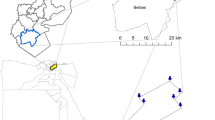Abstract
The suppressive effect of vernonia (Vernonia amygdalina), amaranth (Amarathus sp.) and poultry manure on root-knot nematodes (RKNs) (Meloidogyne spp.) infecting eggplant (Solanum macrocarpon) was studied at two sites in southern Benin naturally infested with these nematodes. After 3 months, soil and root-inhabiting RKN populations were significantly less (P≦0.05) in the plots cropped with vernonia, amaranth, and eggplant amended with poultry manure (PM) at the rate of 40 t ha−1 as compared with the rate of 20 t ha−1 and with the control. Poultry manure was more effective after 2 months than after 3 months. Overall, vernonia was the most effective treatment affecting RKN populations in the roots and the soil. The use of these treatments in nematode management through rotation and co-planted crops is discussed.
Similar content being viewed by others
References
Akhtar, M. (1999) Plant growth and nematode dynamics in response to soil amendments with neem products, urea and compost.Bioresour. Technol. 69:181–183.
Asmus, G.L., Inomoto, M.M., Sazaki, C.S.S. and Ferraz, M.A. (2005) Reaction of some cover crops used in the no-tillage system toMeloidogyne incognita.Nematol. Bras. 29:47–52.
Barker, K.R. and Niblack, T.L. (1990) Soil sampling methods and procedures for field diagnosis.in: Zuckerman, B.M., Mai, W.F. and Krusberg, L.R. [Eds.] Plant Nematology Laboratory Manual. Revised Edition. The University of Massachusetts Agricultural Experiment Station, Amherst, MA, USA. pp. 10–19.
Chindo, P.S. and Khan, F.A. (1990) Control of root-knot nematodes,Meloidogyne spp., on tomato,Lycopersicon esculentum Mill., with poultry manure.Trop. Pest Manag. 36:332–335.
D’Addabbo, T., Sisanelli, N., Lamberti, F., Greco, P. and Carella, A. (2003) Olive pomace and chicken manure amendments for control ofMeloidogyne incognita over two crop cycles.Nematropica 33:1–7.
Datta, S.C., Datta, R., Sukul, A., Sukul, N.C. and Sinhababu, S.P. (2000) Relative attractiveness of four species of vegetable crops forMeloidogyne incognita.Environ. Ecol. 18:233–235.
El Allagui, N., Bourijate, M., Tahrouch, S. and Hatimi, A. (2006) Effet de cinq extraits végétaux surMeloidogyne spp. de la tomate.International Congress of Biochemistry (Agadir, Morocco), pp. 357–360.
Ferris, H. and Van Gundy, S.D. (1979)Meloidogyne ecology and host interrelationships.in: Lamberty, F. and Taylor, C.E. [Eds.] Root-knot Nematodes (Meloidogyne spp.). Systematics, Biology and Control. Academic Press, London, UK. pp. 205–230.
Hooper, D.J. (1990) Extraction and processing of plant and soil nematodes.in: Luc, M., Sikora, R.A. and Bridge, J. [Eds.] Plant Parasitic Nematodes in Subtropical and Tropical Agriculture. CAB International, Wallingford, UK. pp. 45–68.
Jagdale, G.B., Pawar, A.B. and Darekar, K.S. (1985) Effect of organic amendments on root-knot nematodes infecting Betelvine.Int. Nematol. Network Newsl. 2:5–10.
James, B., Godonou, I., Atcha, C. and Baimey, H. (2006) Healthy vegetables through participatory IPM in peri-urban areas of Benin. Summary of activities and achievements, 2003–2006. International Institute of Tropical Agriculture, Cotonou, Benin.
Johnson, A.W. (1985) The role of nematicides in nematode management.in: Sasser, J.N. and Carter, C.C. [Eds.] An Advanced Treatise onMeloidogyne. Vol. 1. Biology and Control. North Carolina University Graphics, Raleigh, NC, USA. pp. 249–267.
Khan, T.A. and Saxena, S.K. (1997) Integrated management of root-knot nematodesMeloidogyne javanica infecting tomato using organic materials andPaecilomyces lilacinus.Bioresour. Technol. 61:247–250.
Kimpinski, J., Gallant, C.E., Henry, R., Macleod, J.A., Sanderson, J.B. and Sturz, V.A. (2003) Effect of compost and manure soil amendments on yields of potato and barley: a 7-year study.J. Nematol. 35:289–293.
Lian, S. (1993) Use of chemical fertilizers combined with organic manure in rice production. External Bull. no. 371. Food Fertilizer Technology Center, Wales, UK.
McSorley, R. and Gallaher, R.N. (1996) Effect of yard waste compost on nematode densities and maize yield.J. Nematol. 28 (suppl.):655–660.
McSorley, R. and Gallaher, R.N. (1997) Effect of compost and maize cultivars on plant parasitic nematodes.J. Nematol. 29:731–736.
Oka, Y., Ben-Daniel, B. and Cohen, Y. (2001) Nematicidal activity of powder and extracts ofInula viscose.Nematology 3:735–742.
Okezie, A. and Agyakwa, C.W. (1989) Guide des Adventices d’Afrique de l’Ouest. Institut International d’Agriculture Tropicale, Ibadan, Nigeria.
Ploeg, A.T. (1999) Greenhouse studies on the effect of marigolds (Tagetes spp.) on fourMeloidogyne species.J. Nematol. 31:62–69.
Ploeg, A.T. and Stapleton, J.J. (2001) Glasshouse studies on the effects of time, temperature, and amendment of soil with broccoli plant residues on the infestation of melon plants byMeloidogyne incognita andM. javanica.Nematology 3:855–861.
Prot, J.C. and Van Gundy, S.D. (1981) Effect of soil texture and the clay component on migration ofMeloidogyne incognita second stage juveniles.J. Nematol. 13:213–219.
Sanchez de Viala, A.S., Brodie, B.B., Rodriguez, E. and Gibson, D.M. (1998) The potential of thiarubrine C as a nematicidal agent against plant-parasitic nematodes.J. Nematol. 30:192–200.
Speijer, P. and De Waele, D. (1997) Screening forMusa germplasm for resistance and tolerance to nematodes. Technical Guidelines No. 1. INIBAP, Montpellier, France.
Stapleton, J.J. and DeVay, J.E. (1983) Response of phytoparasitic and free-living nematodes to soil solarization and 1,3-dichloropropene in California.Phytopathology 73:1429–1436.
Stapleton, J.J. and Duncan, R.A. (1998) Soil disinfestations with cruciferous amendments and sublethal heating: effects onMeloidogyne incognita, Sclerotium rolfsii andPythium ultimum.Phytopathology 47:737–742.
Tsay, T.T., Wu, S.T. and Lin, Y.Y. (2004) Evaluation of Asteraceae plants for control ofMeloidogyne incognita.J. Nematol. 36:36–41.
Van der Laan, P.A. (1956) The influence of organic manure on the development of the potato root-worm,Heterodera rostochiensis.Nematologica 1:112–125.
Viaene, N.M. and Abawi, G.S. (1996) Damage threshold ofMeloidogyne hapla to lettuce in organic soil.J. Nematol. 28:537–545.
Viaene, N.M. and Abawi, G.S. (1998) Management ofMeloidogyne hapla on lettuce in organic soil with sudangrass as a cover crop.Plant Dis. 82:945–952.
Widmer, T.L. and Abawi, G.S. (2000) Mechanism of suppression ofMeloidogyne hapla and its damage by a green manure of Sudan grass.Plant Dis. 84:562–568.
Author information
Authors and Affiliations
Corresponding author
Additional information
http://www.phytoparasitica.org posting August 6, 2008.
Rights and permissions
About this article
Cite this article
Afouda, L., Baimey, H. & Fanou, H. Evaluation ofAmaranthus sp. andVernonia amygdalina, and soil amendments with poultry manure for the management of root-knot nematodes on eggplant. Phytoparasitica 36, 368–376 (2008). https://doi.org/10.1007/BF02980816
Received:
Accepted:
Issue Date:
DOI: https://doi.org/10.1007/BF02980816




